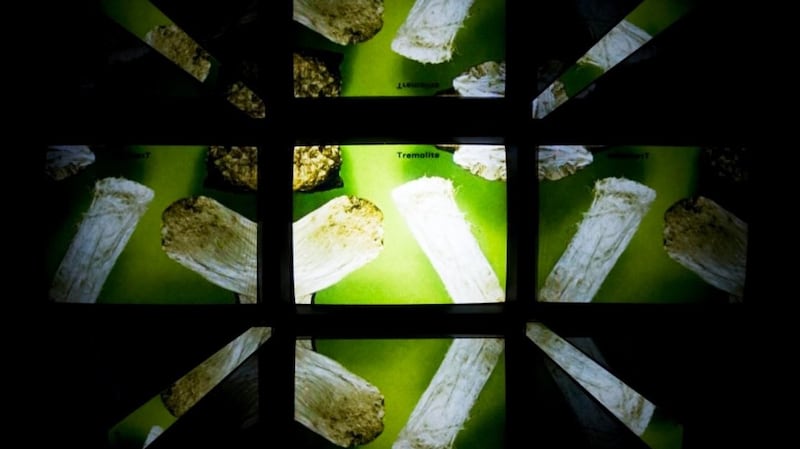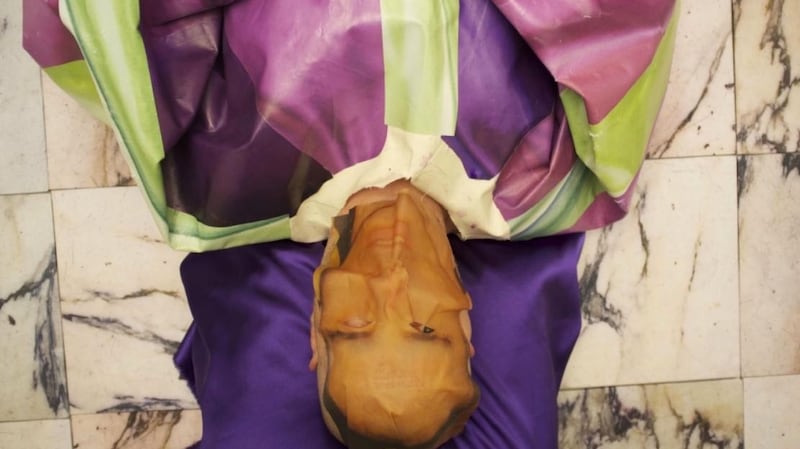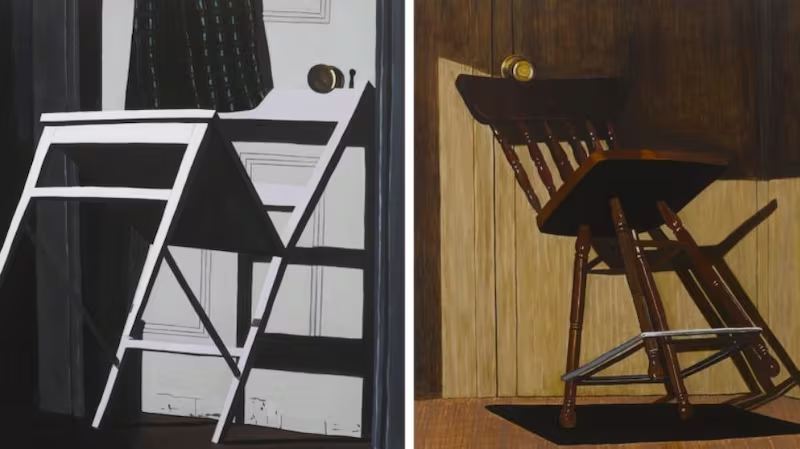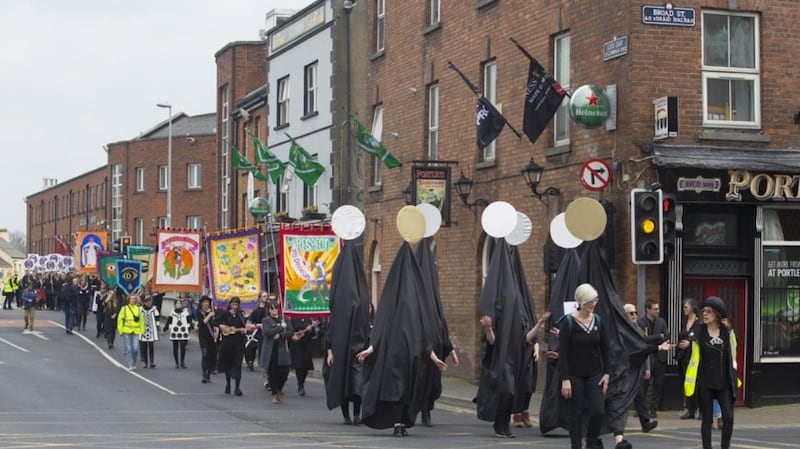With four selectors and an open, inclusive rationale, Pallas's Periodical Review is not thematically focused or constrained, but this year, in Review #8, a relatively packed but deftly presented show, variations on one general motif or idea recur. That is the idea of disjuncture or rupture, in terms of time, space and more. It informs even the appearance of the overall installation, which has a fragmentary, jagged character (not dissimilar, strikingly, to Futures at the RHA).
This year Gavin Murphy and Mark Cullen of Pallas are joined by two external curators, James Merrigan and Aisling Prior, both with impressive track records. Each of the four proposes five artists, though Murphy's five includes the multiple members of the collective Artists' Campaign to Repeal the Eighth, represented in the show by Áine Phillips's graphically elegant Eye banners, from a series produced by the group.
There’s also Mia Mullarkey’s filmed account of the group’s performance at EVA International. It’s agitprop of its – our – time, but it also directly recalls, a century on, the fight for women’s rights in the early 20th century and is hence a reminder that the fight has been continuous. Sophie Daly’s short video animation is an ingenious reflection on the relationship between women and the Catholic Church, in which leaded stained-glass windows morph into representations of the female reproductive system.
Science fiction
Cullen writes on Dennis McNulty's the here and now/crystalline space which, though recently exhibited, dates from 2008. He notes that McNulty included Ursula Le Guin's science-fiction novel The Dispossessed among a selection of influences. The novel apparently concerns the development of an instantaneous communications device that collapses distances in both space and time. McNulty's video, viewed through a two-way mirror, is accompanied by an episodic voice-over recounting examples of comparable collapses, as layers of the surrounding environment peel away and in one case a city, built on a crystalline deposit in the desert, proves impossible to locate by any conventional means. It's a particularly atmospheric piece.


Susan Buttner’s installation of architectural elements, a sort of open-ended scale model, is juxtaposed with a dance video in which the human body is set within and against a spacious interior in an exploratory, tentative way. There’s a lot of potential here. Her installation chimes well with Cliodhna Timoney’s, which seems to dismantle a domestic interior and reconstruct it free-form, like 3-D cubism (early electronic music was a significant source of inspiration).
In his performance film Integrated Mystery House, Sam Keogh doesn't quite manage to clinch the connections he makes between Silicon Valley, the labyrinthine nature of both silicon chips and the Winchester Mystery House – and the V2 rocket. The convoluted house in question was built by the widow of the man whose company developed the Winchester repeating rifle, apparently with the aim of accommodating the spirits of all those the rifles had killed.
Commemorating the dead also features in Austin Hearne’s staged photograph, which evokes the ritualistic veneration of saints.
Megan Burns's excellent site-specific paintings, hard-edge abstractions, redefine the spaces they occupy. One could say the same of Robert Dunne's equally impressive painterly sculpture, or sculptural painting, Equal. The equal parts are a smoothly plastered oblong and a raw, structural oblong. You may have seen Brian Maguire's Aleppo paintings during the year, but evidently Brexit has spurred him to address a pressing issue closer to home. His Border X248551 Y325563 is a strip of tarmac fringed by a verge, through which runs an all but invisible line that could become all too concrete.
Ciara O’Neill’s prints, one a scene from the dramatic Dublin city eviction policed by balaclava-wearing security guards, use the visual language of promotion, marketing and advertisement to highlight contentious issues.
Lee Welch has been dealt a hand of tarot cards in response to specific questions – 10 cards per question. These mysterious but emotionally charged images spark his paintings. Marie Farrington’s cast plaster panels recall the decorative arts of Georgian interiors, though their provenance is more prosaic: the surfaces of mobile homes at a coastal site.
Similarly, Sean O’Rourke’s matter-of-fact representational paintings are made on the rusted steel panels that blocked the windows of uninhabited flats at Dolphin House.
Diptych
Stephen Loughman is represented by a brilliant diptych from his Proven Answers exhibition at Temple Bar Gallery during the year. Each is taken from a still from a horror film (The Babadook and It Follows), and each features the common trope of a chair wedged against the door in a desperate, usually vain attempt to block invasion.
Bassam Al-Sabah, who also features in Futures, refers to the anime films of his early years, a fantasy background to the brutal reality of events that took that world away forever.


Look up and you'll see some of the embroidered fruits of Fiona Reilly's research project, The Department of Time Keepers. In the courtyard, there are two of Seoidín O'Sullivan's fruit tree grafts from her environmental project Hard Graft: Towards Community Orchards.
Celina Muldoon looks for connections between ancient cultural practices and today’s youth cultures. Her fearsome Fomorian is a huge, interactive (she uses sculptural elements as costume in performance) head and shoulders of Balor, the mythological Irish king. There is nothing quite like Pallas’s Periodical Review, and not the least of its achievements is proving that it can be done, and done very well, with stringently limited resources.











